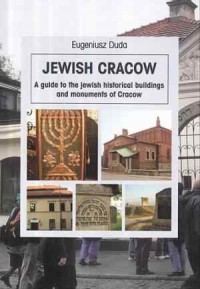Jewish Cracow. A guide to the jewish historical buildings and monuments of Cracow
Eugeniusz Duda

| Dane szczegółowe: | |
| Wydawca: | Etiuda |
| Rok wyd.: | 2003 |
| Oprawa: | miękka |
| Ilość stron: | 127 s. |
| Wymiar: | 120x170 mm |
| EAN: | 9788391825556 |
| ISBN: | 83-918255-5-8 |
| Data: | 2001-01-09 |
Opis książki:
An exceptionally large number of historical buildings and monuments associated with Jewish history and culture survive in Kraków. The ma)ority arę in Kazimierz, where the umque framework of the old Jewish town, which flourished from the end of the rourteenth century to the middłe of the nineteenth, has survived. The most important historical buildings and sites arę the Old, Remu (New), High, Popper, Isaac and Kupa synagogues and the old cemetery around the Remu synagogue. But it is not oniy in Kazimierz ftiat important Jewish historical buildings have survived in Kraków. A good deal less venerable than Kazimierza synagogues they arę the structural remains of the multifaceted growth and development of Jewish society in the nineteenth and twentieth centuries. Good examples arę the Tempel or Progressive, synagogue on Ul. Miodowa and, on Ul. Skawińska, the headquarters of the Jewish town councii and the building that used to house the Jewish hospital. But throughout the city there arę many morę educational, cultural, charitable and sporting historical buildings and sites built by Krakóws Jews. Few traces of its Jewish past have survived in Kazimierzs neighbouring Stradom district, which was settied oniy in the second half of the nineteenth century and in the twentieth, or in the city centre. Though it is true that Jews were aiready present m Krakóws old town in the thirteenth century, by the end ot the fifteenth they had been expelled. They were to return oniy in the second half of the nineteenth century after securing citizenship rights. Remembering that it was precisely Krakóws main market square (Rynek Główny) that was the first site of institutionalised Jewish lite in the city we begin our journey of exploration there. Leaving the main market square via Ul. Grodzka and, moving on through Stradom to Kazimierz and the old Jewish town, we arę tracing the steps taken at the end ot the fitteenth century by expelled Kraków Jews and those ot many of their descendants returning in the opposite direction in the nineteenth century as fuli citizens. The first section has been divided into two routes: 1. Rynek Główny - Ulica Bocheńska 2. Ulica Józefa - Ulica Przemyska In the Podgórze district, on the right bank of the Wisła, lie sites, relics and monuments of the extermination of the Kraków Jews in the Second Worid War. We visit this area, the ghetto and the Plaszów concentration camp following a third route: 3. Plac Bohaterów Getta - Ptaszów Ali three routes can be completed in a day. But for those who have, at most, oniy a few hours, we suggest visiting the most important monuments and historical buildings that are the subject of Route 2. These may be found on the pages marked in green.
Książka "Jewish Cracow. A guide to the jewish historical buildings and monuments of Cracow" - Eugeniusz Duda - oprawa miękka - Wydawnictwo Etiuda. Książka posiada 127 stron i została wydana w 2003 r.
Spis treści:
Route 1 - Rynek Główny - Ul. Bocheńska
Route 2 - Ul. Józefa - Ul. Przemyska
Route 3 - Plac Bohaterów Getta - Ptaszów
A Selected Bibtiography
Jewish Instttutlons and Cultural Promoters

